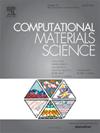Dislocation properties in BCC refractory compositionally complex alloys from atomistic simulations
IF 3.1
3区 材料科学
Q2 MATERIALS SCIENCE, MULTIDISCIPLINARY
引用次数: 0
Abstract
Body-centered cubic (BCC) refractory compositionally complex alloys (RCCAs) have emerged as promising candidates for aerospace, nuclear energy, and automotive applications due to their exceptional high-temperature strengths. It is well-known that dislocations play a critical role in the mechanical properties of refractory alloys. In this study, we examine the fundamental properties of edge and screw dislocations, including core energies and dislocation shear stresses (DSSs) in MoNbTi, NbMoTaW, and CrTaVW, at various temperatures using atomistic simulations with the state-of-the-art machine-learned interatomic potentials (MLIPs). Our findings reveal that at high temperatures, the DSS of edge dislocations exceed those of screw dislocations in MoNbTi and NbMoTaW alloys. This behavior is attributed to cross-kink diffusion and annihilation in screw dislocations, which leads to a more significant decrease in DSS as temperature increases. Furthermore, the DSS values of screw dislocations at low temperatures and those of edge dislocations at high temperatures closely align with experimental yield strengths. These results show that edge dislocations are primarily responsible for the high-temperature strengths of some of the RCCAs and are crucial for tuning their mechanical properties. Additionally, we observe that screw dislocations exhibit lower core energies than edge dislocations across all temperatures in the investigated alloys, indicating their greater thermodynamic stability. These findings underscore the importance of considering different types of dislocations at various temperature regimes in BCC RCCAs, which is essential for guiding alloy design within the vast compositional space.

基于原子模拟的BCC难熔复合合金位错特性研究
体心立方(BCC)复合耐火合金(RCCAs)由于其优异的高温强度,已成为航空航天、核能和汽车应用的有前途的候选者。众所周知,位错对耐火合金的力学性能起着至关重要的作用。在这项研究中,我们使用最先进的机器学习原子间势(MLIPs)原子模拟,研究了在不同温度下,MoNbTi、NbMoTaW和CrTaVW中边缘和螺旋位错的基本特性,包括核心能量和位错剪应力(DSSs)。结果表明,在高温下,MoNbTi和NbMoTaW合金的边缘位错的DSS大于螺位错。这种行为归因于螺位错中的交结扩散和湮灭,这导致DSS随温度升高而更显着降低。此外,螺旋位错在低温下的DSS值和边缘位错在高温下的DSS值与实验屈服强度密切相关。这些结果表明,边缘位错是某些rcca高温强度的主要原因,并且对于调整其机械性能至关重要。此外,我们观察到,在所研究的合金中,在所有温度下,螺位错都比边缘位错表现出更低的核心能量,表明它们具有更大的热力学稳定性。这些发现强调了在BCC RCCAs中考虑不同温度下不同类型位错的重要性,这对于在广阔的成分空间内指导合金设计至关重要。
本文章由计算机程序翻译,如有差异,请以英文原文为准。
求助全文
约1分钟内获得全文
求助全文
来源期刊

Computational Materials Science
工程技术-材料科学:综合
CiteScore
6.50
自引率
6.10%
发文量
665
审稿时长
26 days
期刊介绍:
The goal of Computational Materials Science is to report on results that provide new or unique insights into, or significantly expand our understanding of, the properties of materials or phenomena associated with their design, synthesis, processing, characterization, and utilization. To be relevant to the journal, the results should be applied or applicable to specific material systems that are discussed within the submission.
 求助内容:
求助内容: 应助结果提醒方式:
应助结果提醒方式:


